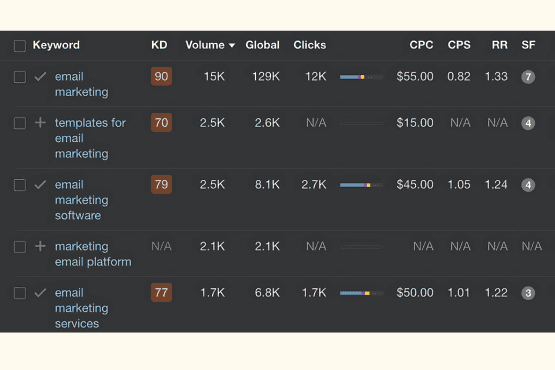Launching a new website is exciting, but ranking it well on Google can be an uphill battle. With millions of sites competing for attention, how do you make yours stand out? This guide will walk you through proven strategies to boost your new site’s visibility and climb those search engine results pages (SERPs). Let’s explore how to rank a new website on Google.
Foundational SEO Setup
Before diving into content creation and link building, you must lay the groundwork for SEO success. This involves essential tasks that make your site more discoverable and user-friendly.
Keyword Research: The Core of SEO
At the heart of any successful SEO strategy lies thorough keyword research. This process helps you understand what your target audience is searching for and how to align your content with those queries.
Why Keywords Matter
Keywords bridge what people are searching for and the content you provide, helping you rank higher. By targeting the right keywords, you increase your chances of appearing in relevant searches and attracting qualified traffic to your site.
Tools for Effective Research
Several tools can aid your keyword research efforts:
| Tool | Key Features | Best For |
|---|---|---|
| Google Keyword Planner | Free, integrates with Google Ads | Basic keyword ideas and search volume data |
| Ahrefs | Comprehensive data, competitor analysis | In-depth keyword research and content planning |
| SEMrush | Keyword difficulty scores, SERP analysis | Competitive analysis and finding keyword gaps |
| Moz Keyword Explorer | Keyword suggestions, SERP analysis | Beginners and intermediate users who want to rank higher on search engines can benefit from understanding SEO fundamentals. |
Types of Keywords
- Short-tail keywords: Broad, general terms (e.g., “dog food”)
- Long-tail keywords: More specific phrases (e.g., “best organic puppy food for small breeds”)
Focus on a mix of both, emphasizing long-tail keywords for new sites as they often have less competition.
On-Page Optimization: Making Google Understand
On-page optimization involves tweaking various elements on your website to help search engines understand your content better.
Key On-Page Elements
- Title Tags: Include your target keyword near the beginning of your title tag.
- Meta Descriptions: Write compelling summaries that encourage clicks.
- Header Tags (H1, H2, H3): Use a logical structure and include relevant keywords.
- URL Structure: Keep URLs short, descriptive, and keyword-rich.
- Image Alt Text: Describe images accurately and include keywords where appropriate.
Internal Linking Strategies
Internal links help distribute page authority throughout your site and guide users to related content. Implement a logical linking structure that connects your most important pages.
Technical SEO: The Backbone of Your Website
Technical SEO ensures your site is crawlable and indexable and provides a good user experience.
Site Speed Optimization
A fast-loading site is crucial for both user experience and SEO. Use Google’s PageSpeed Insights to identify and fix speed issues.
| Speed Improvement Tip | Impact |
|---|---|
| Optimize images | Reduce file sizes without sacrificing quality |
| Enable browser caching | Store static files locally on user devices |
| Minify CSS, JavaScript, and HTML | Remove unnecessary characters from the code |
| Use a content delivery network (CDN) | Serve content from servers closer to users |
XML Sitemap Creation
An XML sitemap helps search engines discover and index your pages more efficiently. Use a tool like XML-Sitemaps.com to generate one, then submit it through Google Search Console.
SSL Implementation
Secure your site with an SSL certificate to enable HTTPS. This not only protects user data but also provides a slight ranking boost.
Mobile-First: Catering to the Modern User
With mobile devices accounting for over half of web traffic, optimizing for mobile is no longer optional.
Mobile-Friendly Design Principles
- Responsive layouts that adapt to screen sizes
- Large, easily tappable buttons and links
- Readable font sizes without zooming
- Avoid using Flash or other mobile-unfriendly technologies
Test your site’s mobile-friendliness using Google’s Mobile-Friendly Test tool and address any issues it identifies.
Crafting SEO-Friendly Material
Quality content is the foundation of any successful SEO strategy. It’s what attracts visitors, earns links, and establishes your site as an authority in your niche, ultimately helping you rank higher.
Quality Over Quantity: The Content Rule
While it’s important to publish regularly, never sacrifice quality for quantity. High-quality content:
- Provides valuable information or solves a problem
- It is well-researched and factually accurate
- Engages readers with clear, concise writing that helps them find the content they want to rank for.
- Includes relevant multimedia elements (images, videos, infographics)
Search Intent: Matching User Needs
Understanding and catering to search intent is crucial for ranking well. There are four main types of search intent:
- Informational: Users seeking information (e.g., “how to bake a cake”)
- Navigational: Users looking for a specific website (e.g., “Facebook login”)
- Commercial: Users researching products or services (e.g., “best running shoes”)
- Transactional: Users ready to make a purchase (e.g., “buy iPhone 13 Pro”)
Tailor your content to match the intent behind your target keywords. For example, a blog post might be appropriate for informational queries, while a product page suits transactional intent.
Evergreen vs. Trending: Finding the Balance
Mixing evergreen and trending content can help you attract short-term traffic spikes and sustained long-term interest.
| Content Type | Benefits | Examples |
|---|---|---|
| Evergreen | Provides long-term value, requires less frequent updates | How-to guides, FAQs, product reviews |
| Trending | Capitalizes on current interest, can generate quick traffic | News articles, seasonal content, event coverage |
Aim for a content calendar that includes both types, with a heavier focus on evergreen pieces for sustained traffic.
Content Promotion: Getting Your Content Seen
Creating great content is only half the battle; you must promote it effectively.
Social Media Promotion
Share your content across relevant social platforms using eye-catching visuals and engaging captions. Consider using paid promotion for your best-performing pieces to extend their reach.
Guest Blogging and Partnerships
Collaborate with other websites in your niche to expand your audience and earn valuable backlinks. Seek out guest posting opportunities or create co-branded content with complementary businesses.
Building Authority and Trust
Establishing your site as a trusted authority takes time, but it’s essential for long-term SEO success.
Backlinks: The Currency of SEO
Quality backlinks from reputable sites signal to search engines that your content is valuable and trustworthy.
Effective Link-Building Strategies
- Create linkable assets: Develop high-quality resources that others naturally want to link to (e.g., original research, comprehensive guides, infographics).
- Outreach: Reach out to relevant websites and offer your content as a valuable resource for their audience.
- Broken link building is a strategy that can enhance your site’s SEO and help you rank higher on Google.: Find broken links on other sites and offer your content as a replacement.
- HARO (Help a Reporter Out): Provide expert quotes for journalists and earn media mentions.
Internal Linking: Guiding Users and Google
A strong internal linking structure helps distribute link equity throughout your site and improves user navigation.
Best Practices for Internal Linking
- Use descriptive anchor text
- Link to relevant, high-value pages
- Create content hubs around key topics
- Update old content with links to newer, related pieces to help Google understand your site’s relevance.
Social Signals: The Ripple Effect
While social media engagement isn’t a direct ranking factor, it can indirectly boost your SEO efforts by:
- Increasing brand awareness and visibility
- Driving traffic to your site
- Encouraging natural link building
- Improving content distribution
Engage with your audience on social platforms by responding to comments, sharing user-generated content, and participating in relevant discussions.
Domain Authority: The Long Game
Domain Authority (DA) is a metric developed by Moz that predicts how well a site will rank on search engines, particularly in the context of search engine optimization. While it’s not a Google ranking factor, it’s a helpful indicator of your site’s overall SEO health.
Strategies for Improving Domain Authority
- Consistently publish high-quality content
- Earn high-quality backlinks from authoritative sites
- Improve your site’s technical SEO
- Build a strong social media presence
- Ensure your site provides a great user experience
Remember that improving DA takes time – focus on these strategies consistently, and you’ll see gradual improvements.
Measuring and Adapting: Refining Your SEO Strategy
To succeed in SEO, you must track your progress and adjust your tactics based on data-driven insights.
Google Analytics and Google Search Console: Your SEO Tools
These free tools from Google provide invaluable data about your site’s performance and visibility in search results, helping you to rank higher on Google.
Key Metrics to Track in Google Analytics
- Organic traffic
- Bounce rate
- Time on site
- Pages per session
- Conversion rate
Useful Data from Google Search Console
- Search queries driving traffic to your site
- Click-through rate (CTR) for different queries can indicate how well your content is optimized for search terms.
- Indexing the status of your pages
- Mobile usability issues can affect how well your site ranks higher on Google.
- Core Web Vitals performance
Tracking Keywords and Rankings: The Scoreboard
Monitor your target keywords’ rankings to gauge your SEO progress. Tools like Ahrefs, SEMrush, or Moz can help you track rankings over time and identify opportunities for improvement.
Analyzing User Behavior: Understanding Your Audience
Study how visitors interact with your site to identify areas for improvement:
- Which pages have the highest bounce rates?
- Where do users typically exit your site, and how can you use this information to improve your search engine optimization?
- Which content generates the most engagement?
- How do users navigate your site to find the search terms they seek?
Use these insights to refine your content strategy and improve user experience, which can help you rank higher.
Adapting Your Strategy: The SEO Evolution
SEO is an ever-changing field. Stay informed about algorithm updates and industry trends to keep your strategy current.
Tips for Staying Updated
- Follow reputable SEO blogs and news sites
- Attend webinars and conferences
- Experiment with new techniques on a small scale
- Network with other SEO professionals to share strategies to help you rank higher on Google.
Search Engine Optimization Journey with Online Boost
While these strategies are powerful, implementing them effectively can be time-consuming and complex. That’s where Online Boost comes in. As SEO experts, we understand the intricacies of ranking new websites and can help you navigate the ever-changing digital landscape.
Don’t let your great website go unnoticed. Partner with Online Boost to:
- Develop a tailored SEO strategy for your unique business needs
- Implement cutting-edge optimization techniques
- Create engaging, keyword-rich content that resonates with your audience
- Build high-quality backlinks to boost your site’s authority
- Track and analyze your SEO performance for continuous improvement
Let us handle the complexities of SEO while you focus on what you do best – running your business. With Online Boost, a team of dedicated experts will work tirelessly to elevate your online presence and drive organic traffic to your site.
Ready to boost your new website’s rankings and outperform your competition? Contact Online Boost today for a free consultation, and let’s start your journey to SEO success!











